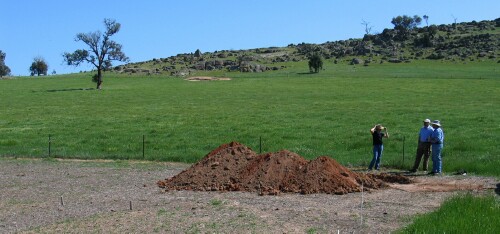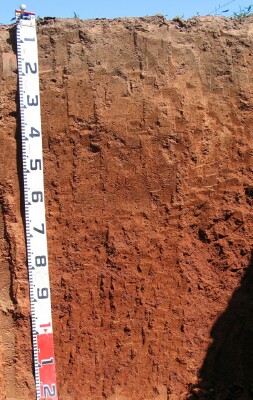NECRC2
| Location: Byawatha | Australian Soil Classification: Bleached, Eutrophic, Red DERMOSOL |
| General Landscape Description: Grazing paddock. | Site Description: Lower slope of gently undulating rise below granite hill. |
| Geology: Devonian Granite |
 NECRC2 landscape |
Soil Profile Morphology:
Surface Soil
A1 | 0-4 cm | Dark brown (7.5YR3/2); sandy loam; weak to moderate coarse blocky structure; firm to very firm consistence (dry); very few (1-2%) small (2-4 mm) quartz fragments; some compaction features; pH 5.4; abrupt change to: |  NECRC2 profile |
A12 | 4-16 cm | Dark brown (7.5YR3/2); light sandy clay loam; weak coarse blocky structure; firm to very firm consistence (dry); pH 4.9; clear change to: | |
A2e | 16-30 cm | Brown (7.5YR4/4), conspicuously bleached (5YR7/2 dry); light sandy clay loam; weak coarse angular blocky structure; weak consistence (slightly moist); very few (~1%) small (2-4 mm) quartz fragments, macropores present; pH 5.1; clear change to: | |
| Subsoil | |||
B11 | 30-40 cm | Yellowish red (5YR5/6); sandy clay loam; weak sub-angular blocky structure; weak consistence (slightly moist); pH 5.9; gradual change to: | |
B12 | 40-65 cm | Yellowish red (5YR4/6); sandy clay loam; weak medium subangular blocky structure; weak to firm consistence (slightly moist); few (~5%) small (2-6 mm) subangular quartz fragments; pH 6.5; gradual change to: | |
B21 | 65-80 cm | Dark red (2.5YR4/6); sandy clay; weak-moderate medium to fine polyhedral structure; weak to firm consistence (slightly moist); pH 6.6; gradual change to: | |
B22 | 80-100 cm | Sandy clay; strong-moderate medium to fine subangular blocky; strong consistence (slightly moist); cutans on ped faces; pH 6.9; gradual change to: | |
B23 | 100-120 cm | Sandy clay; strong consistence (slightly moist); few (~5%) small (2-8 mm) subangular quartz fragments; pH 7.0. | |
Key Profile Features:
- Gradual increase in texture (i.e. clay percentage) down the profile.
Soil Profile Characteristics:
Horizon | pH | Salinity Rating | ||
Surface (A1 horizon) | Strongly Acid | Very Low | Non-Sodic | None |
Subsoil (B21 horizon) | Slightly Acid | Very Low | Non-Sodic | None |
Deeper subsoil (at 100-120 cm) | Neutral | Very Low | Non-Sodic | None |

Horizon | Horizon Depth (cm) | pH (water) | pH (CaCl2) | EC 1:5 | Exchangeable Cations | |||
Ca | Mg | K | Na | |||||
meq/100g | ||||||||
A1 | 0-4 | 5.4 | 4.9 | 0.15 | 5.6 | 0.70 | 0.76 | 0.07 |
A12 | 4-16 | 4.9 | 4.1 | <0.05 | 1.1 | 0.15 | 0.43 | 0.07 |
A2 | 16-30 | 6.1 | 4.3 | <0.05 | 1.5 | 0.23 | 0.35 | 0.06 |
B11 | 30-40 | 5.9 | 5.1 | <0.05 | 2.9 | 0.45 | 0.25 | 0.08 |
B12 | 40-65 | 6.5 | 5.5 | <0.05 | 4.2 | 0.61 | 0.25 | 0.10 |
B21 | 65-80 | 6.6 | 5.8 | <0.05 | 4.2 | 0.77 | 0.29 | 0.08 |
B22 | 80-100 | 6.9 | 6.1 | <0.05 | 6.0 | 1.5 | 0.54 | 0.08 |
B23 | 100-120 | 7.0 | 6.1 | <0.05 | 5.5 | 1.6 | 0.58 | 0.09 |
Horizon | Horizon Depth (cm) | Exchangeable Aluminium (mg/kg) | Exchangeable Acidity (meq/100g) | Field Capacity pF 2.5 | Wilting Point pF 4.2 | Coarse Sand (0.2-2.0 mm) | Fine Sand (0.02-0.2 mm) | Silt (0.002-0.02 mm) | Clay (<0.002 mm) |
A1 | 0-4 | <10 | 7.1 | 32.6 | 8.1 | 28 | 29 | 26 | 10 |
A12 | 4-16 | 120 | 6.9 | 24.9 | 5.4 | 26 | 34 | 28 | 10 |
A2 | 16-30 | 58 | 2.7 | 19.6 | 5.2 | 25 | 35 | 24 | 11 |
B11 | 30-40 | <10 | 3.7 | 19.7 | 6.3 | 22 | 34 | 27 | 15 |
B12 | 40-65 | <10 | 2.5 | 19.3 | 7.2 | 25 | 30 | 25 | 17 |
B21 | 65-80 | 1.8 | 19.0 | 7.9 | 29 | 27 | 24 | 18 | |
B22 | 80-100 | 3.4 | 21.0 | 10.7 | 28 | 23 | 22 | 27 | |
B23 | 100-120 | 2.8 |
Management Considerations:
- The level of exchangeable aluminium is reasonably high in the very strongly acid subsurface (A12) horizon. This is likely to restrict plants such as lucerne. A paddock-based sample is best to assess this though – i.e. a bulked sample from across the paddock. Exchangeable aluminium levels decrease down the profile as it becomes less acid.
- The profile is likely to be well drained and presents few physical restrictions to root growth.
Notes: Soil profile described by Mark Imhof and Will Gates (December 2004)


